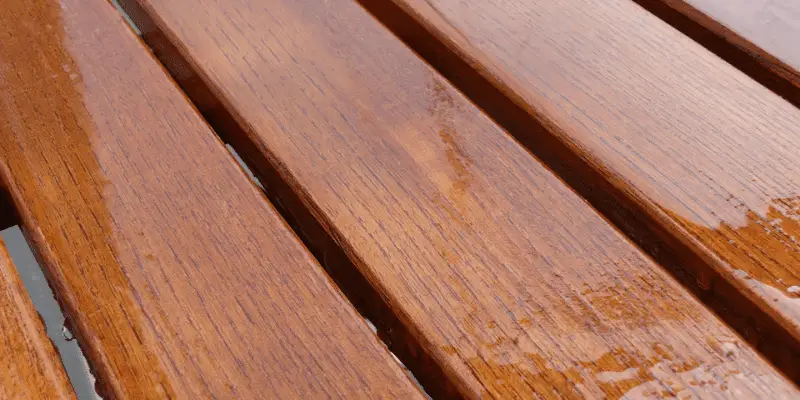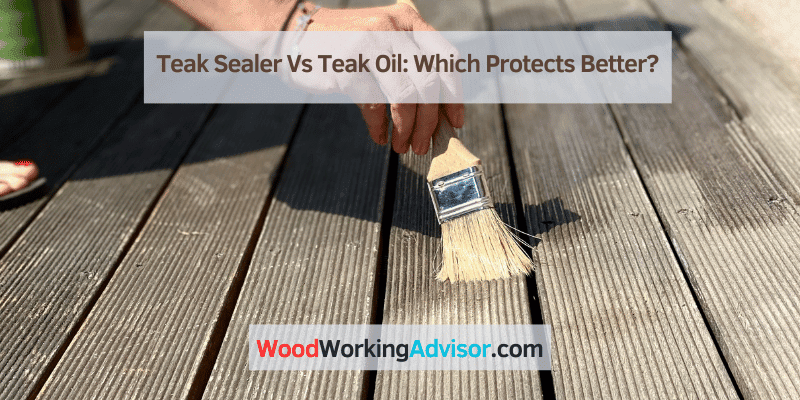When choosing between teak sealer and teak oil, it’s important to consider the differences in their protective properties for teak wood. Teak sealer provides a protective layer that prevents moisture damage and UV rays, while teak oil penetrates the wood to nourish and enhance its natural color.
Both products offer different levels of protection and maintenance for teak furniture and outdoor structures. Understanding their unique features and benefits can help you make an informed decision on which product best suits your needs. Teak sealer and teak oil are popular options for maintaining and protecting teak wood.
Each product has its own distinct advantages and application methods. This article will delve into the differences between the two, providing an overview of their protective properties and offering guidance on choosing the right product for your specific needs. By the end of this discussion, you will have a better understanding of the benefits of teak sealer and teak oil, enabling you to make an informed decision on how to best care for your teak wood items.
Understanding The Properties Of Teak Wood
Teak wood is renowned for its exceptional durability, weather resistance, and stunning natural characteristics. It is highly sought after for outdoor furniture and boat decks due to its innate ability to withstand the elements. In this article, we will delve into the essential properties of teak wood, comparing the benefits of teak sealer versus teak oil in preserving and enhancing its natural qualities.
Natural Characteristics
Teak wood is recognized for its beautiful golden-brown hue and unique grain patterns, making it an attractive choice for various woodworking projects. Its high natural oil content contributes to inherent weather resistance and protection against pests, rendering it highly sought after for outdoor applications.
Durability And Weather Resistance
Teak is renowned for its exceptional durability, making it a prime choice for outdoor furniture that can withstand the elements. It has a natural resistance to rot, moisture, and UV rays, which sets it apart from many other wood species. This attribute ensures that teak furniture maintains its pristine appearance even after prolonged exposure to harsh weather conditions.
Vulnerability To Decay And Discoloration
While teak wood possesses remarkable natural properties, it can still be susceptible to decay and discoloration if not properly maintained. Exposure to moisture and sunlight can lead to a weathered appearance over time. Understanding the best methods for preserving teak wood is crucial to ensuring its longevity and maintaining its stunning appearance.
Teak Oil: Pros And Cons
When considering the care and maintenance of teak wood, one common choice is applying teak oil. This natural oil is renowned for its ability to penetrate the outer layers of teak and enhance its natural beauty. However, there are also certain drawbacks to using teak oil, which make it important to weigh the pros and cons before deciding whether to use this maintenance method for your teak furniture or decking.
Penetrative Properties
One of the key advantages of teak oil is its ability to penetrate deep into the wood, nourishing and protecting it from the inside out. This deep penetration helps strengthen the wood and provides a longer-lasting protective barrier against the elements, making it a preferred choice for outdoor teak furniture or decking.
Enhancing The Natural Color Of Teak
Teak oil has a remarkable capability to enhance the natural color and grain of teak wood, bringing out its rich, warm tones. This helps to maintain the aesthetic appeal of teak furniture and prevents it from fading or deteriorating due to prolonged exposure to sunlight and other environmental factors.
Regular Maintenance Requirements
Despite its numerous benefits, teak oil requires regular reapplication to maintain its protective properties. Exposure to outdoor elements such as sunlight, rain, and humidity can cause the oil to break down over time, necessitating frequent reapplication to ensure the wood remains adequately protected. This regular maintenance can be time-consuming and requires a commitment to ongoing care.
Moreover, the application of teak oil can also lead to a darkening of the wood’s natural color over time, which may not be desirable for some homeowners seeking to maintain a lighter teak finish.

Teak Sealer: Pros And Cons
Protective Coating
Teak sealer serves as a protective barrier, creating a shield against harsh elements such as rain, sunlight, and mould growth. It forms a clear film on the teak surface, preventing the wood from deteriorating due to exposure to moisture and dirt. When applied correctly, a teak sealer acts as a barrier, protecting the natural beauty of the wood from environmental damage.
Resistance To Uv Rays And Moisture
One of the key advantages of using a teak sealer is its ability to resist UV rays and moisture. The sealer creates a protective layer that prevents the teak from graying when exposed to sunlight and helps to maintain its natural color. Additionally, it reduces the risk of cracking and warping caused by moisture penetration, making it a practical choice for outdoor furniture and decking.
Longevity And Maintenance Considerations
Teak sealer offers long-lasting protection for teak wood, extending the lifespan of the furniture or decking. However, it’s important to note that regular maintenance is required to uphold the protective qualities of the sealer. Periodic reapplication is necessary to ensure that the teak remains shielded from exterior forces. Proper care and maintenance are vital to maximizing the benefits of using a teak sealer.
Comparative Analysis: Teak Sealer Vs Teak Oil
When it comes to maintaining and protecting teak furniture, two popular options include teak sealer and teak oil. Let’s delve into a comparative analysis of these two products to understand their effectiveness in protecting against weathering, impact on the natural appearance of teak, and long-term maintenance and durability.
Effectiveness In Protecting Against Weathering
Teak Sealer: Teak sealer provides a robust barrier against weathering elements such as UV rays, rain, and dirt. It forms a protective layer on the surface of the wood, preventing moisture from seeping in and causing damage. This helps to prolong the lifespan of the teak furniture by shielding it from weather-related deterioration.
Teak Oil: Teak oil penetrates into the wood, nourishing and hydrating it, which in turn provides some level of protection against weathering. However, when compared to teak sealer, its effectiveness in providing long-term protection is relatively lower as it doesn’t form a physical barrier against external elements.
Impact On The Natural Appearance Of Teak
Teak Sealer: When applied, teak sealer often alters the natural appearance of teak by imparting a glossy or matte finish. This can enhance the wood’s color, bringing out its natural beauty while also providing protection against discoloration caused by sunlight and other environmental factors.
Teak Oil: Teak oil is known for enriching the natural grain and hue of teak, giving it a warm, lustrous sheen. However, it may not provide as much protection against fading and discoloration compared to teak sealer. Nevertheless, it can accentuate the wood’s natural charm, appealing to those who prefer the original look of teak furniture.
Long-term Maintenance And Durability
Teak Sealer: With its protective barrier, teak sealer offers prolonged durability, reducing the frequency of maintenance required. It helps in retaining the initial appearance for a longer period, thereby reducing the need for frequent reapplications. However, it may require more preparation and effort to reapply when the protective layer wears off.
Teak Oil: While teak oil enhances the appearance, it generally needs to be reapplied more frequently to maintain its protective properties. This regular maintenance can be more time-consuming and may require sanding or cleaning the surface before reapplication to ensure proper adherence. It offers a more natural look but demands consistent upkeep to preserve the wood.
Conclusion: Choosing The Right Protection For Your Teak Furniture
When it comes to preserving the natural beauty and longevity of your teak furniture, selecting the right protection is crucial. Teak is a dense, durable wood that is highly resistant to rot, decay, and warping, but it still requires proper maintenance to maintain its innate splendor. When considering the best way to safeguard your teak furniture, it’s important to weigh the pros and cons of teak sealer versus teak oil, taking into account several key factors.
Factors To Consider
Before deciding between teak sealer and teak oil, it’s essential to assess several factors to ensure the most suitable protection for your teak furniture:
- The desired level of protection: Select a solution based on the level of protection needed, considering factors such as weather exposure and maintenance preferences.
- Longevity and durability: Evaluate the durability and longevity of each option to determine which will provide optimal maintenance.
- Enhancement of natural appearance: Consider whether you want to retain the original color and texture of the teak or if you prefer a specific aesthetic enhancement.
- Application and maintenance: Assess the ease of application and ongoing maintenance required for each protection method to ensure it aligns with your lifestyle.
By carefully considering these factors, you can make an informed decision about the best protection for your teak furniture.
Frequently Asked Questions On Teak Sealer Vs Teak Oil
What Is The Difference Between Teak Sealer And Teak Oil?
Teak sealer is a protective coat that creates a barrier against moisture and UV rays, while teak oil penetrates the wood to nourish and enhance its natural beauty.
How Often Should I Apply Teak Sealer Or Teak Oil?
For optimal protection, reapply teak sealer every 6-12 months or when you notice decreased water beading. Teak oil should be reapplied every 2-3 months for upkeep.
Can I Use Teak Sealer And Teak Oil Together For Better Protection?
While some may apply teak oil first for conditioning and then use teak sealer as a topcoat for added protection, it’s essential to follow the product-specific instructions for compatibility.
Will Teak Sealer Change The Natural Color Of The Wood?
Teak sealer enhances the natural color of teak wood by providing a clear or tinted finish. It won’t significantly alter the wood’s original appearance, but rather enriches it.
Conclusion
Deciding between teak sealer and teak oil for your outdoor furniture? Both offer protection and enhancement, but it ultimately depends on your priorities. While teak oil highlights the wood’s natural beauty, teak sealer provides longer-lasting protection. Consider your specific needs and preferences to make the right decision for your teak furniture maintenance.



One thought on “Teak Sealer Vs Teak Oil: Which Protects Better?”